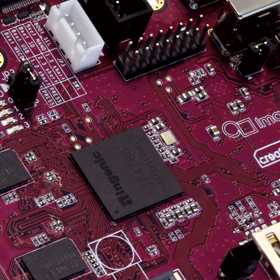// SPDX-License-Identifier: GPL-2.0 /* * arch/sh/drivers/pci/fixups-dreamcast.c * * PCI fixups for the Sega Dreamcast * * Copyright (C) 2001, 2002 M. R. Brown * Copyright (C) 2002, 2003, 2006 Paul Mundt * * This file originally bore the message (with enclosed-$): * Id: pci.c,v 1.3 2003/05/04 19:29:46 lethal Exp * Dreamcast PCI: Supports SEGA Broadband Adaptor only. */ #include <linux/sched.h> #include <linux/kernel.h> #include <linux/param.h> #include <linux/interrupt.h> #include <linux/init.h> #include <linux/irq.h> #include <linux/pci.h> #include <linux/dma-map-ops.h> #include <asm/io.h> #include <asm/irq.h> #include <mach/pci.h> static void gapspci_fixup_resources(struct pci_dev *dev) { <------>struct pci_channel *p = dev->sysdata; <------>struct resource res; <------>struct pci_bus_region region; <------>printk(KERN_NOTICE "PCI: Fixing up device %s\n", pci_name(dev)); <------>switch (dev->device) { <------>case PCI_DEVICE_ID_SEGA_BBA: <------><------>/* <------><------> * We also assume that dev->devfn == 0 <------><------> */ <------><------>dev->resource[1].start = p->resources[0].start + 0x100; <------><------>dev->resource[1].end = dev->resource[1].start + 0x200 - 1; <------><------>/* <------><------> * This is not a normal BAR, prevent any attempts to move <------><------> * the BAR, as this will result in a bus lock. <------><------> */ <------><------>dev->resource[1].flags |= IORESOURCE_PCI_FIXED; <------><------>/* <------><------> * Redirect dma memory allocations to special memory window. <------><------> * <------><------> * If this GAPSPCI region were mapped by a BAR, the CPU <------><------> * phys_addr_t would be pci_resource_start(), and the bus <------><------> * address would be pci_bus_address(pci_resource_start()). <------><------> * But apparently there's no BAR mapping it, so we just <------><------> * "know" its CPU address is GAPSPCI_DMA_BASE. <------><------> */ <------><------>res.start = GAPSPCI_DMA_BASE; <------><------>res.end = GAPSPCI_DMA_BASE + GAPSPCI_DMA_SIZE - 1; <------><------>res.flags = IORESOURCE_MEM; <------><------>pcibios_resource_to_bus(dev->bus, ®ion, &res); <------><------>BUG_ON(dma_declare_coherent_memory(&dev->dev, <------><------><------><------><------><------>res.start, <------><------><------><------><------><------>region.start, <------><------><------><------><------><------>resource_size(&res))); <------><------>break; <------>default: <------><------>printk("PCI: Failed resource fixup\n"); <------>} } DECLARE_PCI_FIXUP_HEADER(PCI_ANY_ID, PCI_ANY_ID, gapspci_fixup_resources); int pcibios_map_platform_irq(const struct pci_dev *dev, u8 slot, u8 pin) { <------>/* <------> * The interrupt routing semantics here are quite trivial. <------> * <------> * We basically only support one interrupt, so we only bother <------> * updating a device's interrupt line with this single shared <------> * interrupt. Keeps routing quite simple, doesn't it? <------> */ <------>return GAPSPCI_IRQ; }
Orange Pi5 kernel
Deprecated Linux kernel 5.10.110 for OrangePi 5/5B/5+ boards
3 Commits
0 Branches
0 Tags
| Donate
